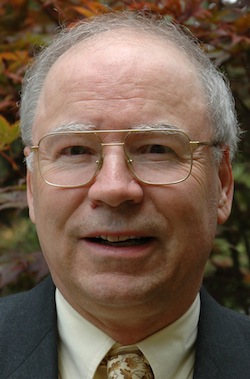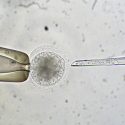Knox, research pioneer in streams and soils, dies
Jim Knox, 70, Evjue-Bascom professor emeritus of Geography at the University of Wisconsin–Madison, died at his home in Madison on Saturday, Oct. 6. Although he had retired in 2011, he continued to work in Science Hall.

Knox
A memorial service will take place on Friday, Oct. 12 at noon, with a visitation beginning at 10 a.m., at Cress Funeral Home, 3610 Speedway Road.
During his 43 years as a faculty member at UW–Madison, Knox’s research transformed the field of fluvial geomorphology (studying streams and the landforms they produce), opening new avenues that linked his field to broader contemporary environmental issues. To tens of thousands of students, he was a much-loved teacher, explaining not only how streams and soils work, but why we should care about them.
“I first met Jim when I was a new Ph.D. student on a field trip through southwestern Wisconsin on a cold, early spring weekend,” recalls Matt Kuchta, now an assistant professor of geology physics at UW-Stout, in a remembrance on his blog. “He had so much to share [that] he would talk to both vans via the walkie-talkie. He spent so much time talking about the rivers and fluvial history of the area [that] he ended up draining the batteries in the walkie-talkie more than once. . . His work on the impact of humans on river systems continues to shape the work that I do now.”
The hills and valleys of Wisconsin’s Driftless Area served as Knox’s “laboratory.” He carried out his best known work near the Grant County farm where he grew up, inspired by the winding streams and the glacial history of the Quaternary Period.
“At a gathering last year to commemorate Jim’s career, former graduate students often turned to descriptions of Jim enthusiastically surveying stream channels in the Driftless Area, in cold, wet weather or fading light,” says Joe Mason, professor of geography. “In recent decades, he told me, he often helped his brother with work on the family farm, once noting that he had gone from putting up hay one afternoon to sitting on a National Science Foundation advisory panel in Washington the next day.”
James C. Knox was born in Platteville on Nov. 29, 1941. His early experiences made him a firm believer in the Wisconsin Idea, and in the value of research and teaching at the University of Wisconsin to the people of the state. After earning degrees from UW-Platteville and the University of Iowa, he came home to Wisconsin to take a faculty position at UW–Madison in 1968.
“As his colleagues, we knew him as a model citizen of his department, university and profession. He was always willing to dedicate his time, good nature and common sense to work for the greater good.”
Joe Mason
Knox’s best-known research was on the sometimes-dramatic changes in the magnitude and frequency of floods and the behavior of streams in general. His widely cited 1993 paper in the journal Nature demonstrated that, over the past several thousand years, even modest changes in climate caused large changes in the frequency of large floods along Driftless Area streams. To detect the effects of land use change, he used metal contamination from 19th century lead and zinc mining as a tracer, showing that the rates of soil erosion and sedimentation on floodplains increased dramatically as forest or prairie was turned into farmland.
Knox also played an important role in encouraging the developers of climate models to compare their simulations of past climates with data from the field. His research, supported by numerous grants from the National Science Foundation, was recognized with awards including the Lifetime Achievement Award from the Association of American Geographers, received earlier this year.
Throughout his career, Knox taught large lecture courses in physical geography with enthusiasm and skill, often using illustrating them with examples from his research. Always happy to explain his work to the public in other venues, he was featured in a PBS program on floods in the Mississippi River basin.
Despite the time he spent on research and teaching, Knox rarely, if ever, turned down requests for service. He chaired his department and the Physical Sciences Divisional Executive Committee, among others. Nationally, he was a councilor of the Association of American Geographers and the American Quaternary Association, chair of Section E (Geology and Geography) of the American Association for the Advancement of Science, and chair of the Quaternary Geology and Geomorphology Division of the Geological Society of America. He was a member of numerous panels and advisory boards of the National Science Foundation and an associate editor of several leading journals in geography and earth science.
Knox conveyed the importance of service to academia to the many graduate students he supervised.
“As his colleagues, we knew him as a model citizen of his department, university and profession. He was always willing to dedicate his time, good nature and common sense to work for the greater good,” says Mason.
Knox is survived by his wife Kathy and daughters Sara and Lezlie, all dedicated educators like himself.
Tags: geography, obituaries

